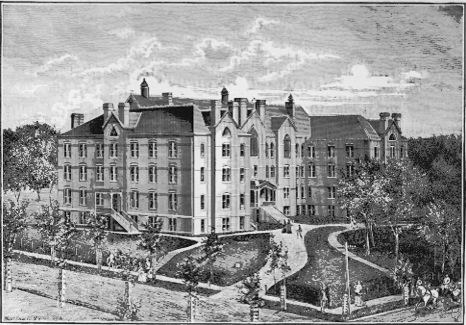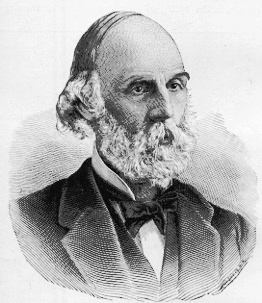|
donated by the ferry company, on
Thirteenth street, between Farnam and Douglas, the site now
being covered by the Omaha National Bank. The Episcopalian
congregation of Trinity church was organized by Rev. G. W.
Watson in 1856, and in 1859 a small brick church was built
on the southwest corner of Farnam and Ninth streets, on
ground leased for ten years. The building ever since 1869
has been used as a beer-hall under the name of the
Tivoli. 
BROWNELL HALL. [Brownell Hall, a
seminary for young ladies, is incorporated under a board of
fifteen trustees, of which the Bishop of Nebraska is
ex-officio president. The school was opened in the northern
part of the city, but was removed to the corner of Sixteenth
and Jones streets in 1867, where buildings were erected and
occupied for twenty years, the school steadily growing in
public confidence and increasing in usefulness under the
rectorship and management, for the last twelve years, of the
Rev. Robert Doherty, S. T. D. The progress of the school, as
well as the city, at length demanded a more suitable
location and enlarged accommodations, and a beautiful site
was chosen on South Tenth street, in a natural grove of fine
forest trees, the gift of Mr. H. Kountze, and the new Hall
was begun in 1886, and occupied in January, 1887. The
building is plain, but of imposing appearance, owing to its
size; is composed of two wings connected by a central
building, somewhat after the ground plan of the Capitol at
Washington, each of these structures being 100x40 feet, with
three stories, an elevated, basement sub-basement and attic.
This great building is lighted, heated, finished and
furnished according to the latest and most approved plans
for educational institutions of this character. It has bath
rooms, with hot and cold water, on each floor; electric
bells, gongs and speaking tubes connect the most distant
parts of the building; three huge boilers furnish steam,
which gives to every room in the building a genial warmth in
the coldest weather; all rooms are perfectly ventilated, and
the furniture and finishing throughout are of the most
beautiful varieties of our native woods, oiled, polished or
varnished. In addition to the spacious recitation rooms,
there is a recreation room, an oratory and gymnasium,
furnishing ample opportunities for needed and healthful
exercise. Altogether it is a thoroughly appointed school and
elegant Christian home, and with its enlarged facilities its
usefulness is practically without limit as a training school
for young ladies in the West, while its success reflects
great credit upon its projectors and steadfast friends, its
manager and teachers, the city of Omaha and State of
Nebraska.] |
|
Richardson. It was opened in elegant
style by M. W. Keith, and was in those days the finest and
largest hotel west of Chicago. It proved too great an
enterprise for Omaha, however, 
MILLARD HOTEL. house was named the Millard in honor of one of the owners and the highly esteemed and influential family of that name. It was opened to the public in July, 1882, when but four stories were finished, the house containing but 130 rooms at the time. Within sixty days the other story was added, and up to the present time two further additions have been made, one of twenty-two feet on the east and another containing forty additional rooms to the rear. The house now contains over two hundred rooms fitted with the finest furniture of any hotel in the State. The two capacious public parlors are luxurious in their elegance and some of the choicest rooms are furnished with a lavish disregard of expense. The Millard, in every department, is admirably appointed and possesses all the modern improvements and conveniences that serve to make hotel life pleasant. There is absolutely no danger from fire. It is not only equipped with Benner's patent stand pipes and fire escapes, but has six fire walls running through and through the building. The kitchens and boiler rooms have been made absolutely fire-proof and the balance of the house is heated by steam. A full force of night employes are trained for an emergency and the danger from the most dreaded of all calamities -- hotel fires -- is reduced to the very minimum. The house has one of the coziest office lobbies in the world and this, with down floor arrangements for the comfort of male guests, makes the Millard the strong favorite it is with the traveling public. The improvements that were made last summer comprised, among other items, one of $10,000 for plumbing, and the house has now the most approved and complete lavatory and sanitary arrangement in the West. Every particle of water used is filtered and purified, a genuine blessing to one familiar with the consistency of Missouri river mud at certain seasons of the year. The Millard is a favorite with local societies and political committees and has long been the headquarters of the Republican State Central Committee. Special quarters are provided by the management for the accommodation of committees, a room being reserved for such gatherings and fitted up solely for that purpose. The present owners, Messrs Markel & Swobe, have been identified with the Millard from the first. Mr. Giacomini first disposed of his share to the remaining four; then Shears, Markel and Swobe purchased Mr. Millard's interest, and in 1886, Mr. Shears disposed of his stock to the two remaining partners. These gentlemen have the most extensive hotel experience and business in the West, having also, as the Pacific Hotel Company, control of eighteen hotels on the line of the Union Pacific Railway, the excellence of which anyone who has traveled over that road can testify. The Millard is under the direct management of Frank McDonald, a gentleman of the highest social qualities and deservedly popular with the guests. A. B. Davenport has held the position of head clerk since the house opened, a most gratifying testimonial of the regard and confidence of the public and his employers. The same can be said of Mr. C. C. Hulett, the cashier, who has occupied the position ever since five months after the hotel was opened. J. E. Strong is key clerk and Frank Watson does the honors to the belated traveler and night guests. The culinary department is under the management of O. N. Davenport, a steward who has made the Millard famous throughout the West.] |
|
|
|
|
